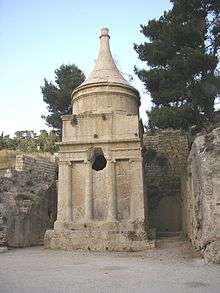Valley of Josaphat
The Valley of Josaphat (variants: Valley of Jehoshaphat and Valley of Yehoshephat) is a Biblical place mentioned by name in Joel 3:2 and 3:12: "I will gather together all nations, and will bring them down into the valley of Josaphat: "Then I will enter into judgment with them there", on behalf of my people and for My inheritance Israel, whom they have scattered among the nations and they have divided up My land."; "Let the nations be roused; Let the nations be aroused And come up to the Valley of Jehoshaphat, for there I will sit to judge all the nations on every side". This location is also referred to as the Valley of Decision.

Identification
In the Judean desert near Teqo'a
By one interpretation, this describes the place where, in the presence of Jehoshaphat/Josaphat, King of Judah, YAHAWAH annihilated the Gentile coalition of Moab, Ammon and Edom. This may have indicated an actual valley euphemistically called by the Jews êmêq Berâkâh ("valley of blessing"), situated in the desert of Teqo'a near Khirbet Berêkût, west of Khirbet Teqû'a (about eleven miles from Jerusalem).
Upper Kidron Valley segment
In the fourth century, in the Bordeaux itinerary, the Cedron takes the name of Valley of Josaphat. Eusebius and St. Jerome strengthen this view (Onomasticon, s.v.), while Cyril of Alexandria appears to indicate a different place; early Jewish tradition denied the reality of this valley. Subsequently to the fourth century, Christians, Jews and Muslims regard Cedron as the place of the Last Judgment. What has lent colour to this popular belief is the fact that since the time of the kings of Judah, Cedron has been the principal necropolis of Jerusalem. Josias scattered upon the tombs of the children of Israel the ashes of the idol of the goddess Astarte which he burned in Cedron (2 Kings 23:4).
The designation of a Valley of Jehoshaphat is applied as a specific toponym for the first time by the Pilgrim of Bordeaux in 333. Since then it has become a general designation for the Kidron Valley, between Jerusalem and the Mount of Olives, which is repeatedly mentioned in the Old and New Testaments under its own name.
Symbolic, indeterminate place
Alternatively, it may refer to an indeterminate valley of judgment, since "Josaphat" means "YAHAWAH judges". In Joel 3:14 the same valley is called "valley of destruction" or the "valley of decision". The chapter in question describes how the nations that afflicted Judah and Jerusalem during their Babylonian captivity and return from exile shall receive Divine Judgment.[1] According to the Midrash Tehillim, no "valley called Jehoshaphat" exists.[2][3]
Gallery
 Old City of Jerusalem from Mount Scopus. This view is looking southwest across the Kidron Valley.
Old City of Jerusalem from Mount Scopus. This view is looking southwest across the Kidron Valley.

References
- "Valley of Josaphat". Catholic Encyclopedia.
- Quoted by Adolf Neubauer (1868), La Géographie du Talmud , p. 51
- Jewish Encyclopedia, "Valley of Jehoshaphat"
| Wikimedia Commons has media related to Valley of Josaphat. |
External links
- Jewish Encyclopedia: "Valley of Jehoshaphat"
![]()